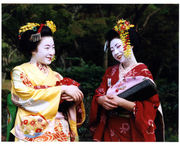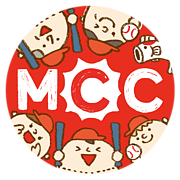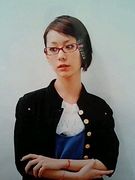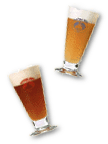通訳案内士(通訳ガイド)試験受験対策<2008年度英語第2次試験の模範解答例(その2)>
東京では、朝夕は、すっかり涼しくなってきましたが、皆様の地方はいかがですか。
いよいよ、勉学の秋、到来ですね!
誰ですか。食欲の秋というのは!(笑)
━━━━━━━━━━━━━━━━━━━━━━━━━━━━━━━━━━━━
英語第2次試験対策「特訓セミナー」のテキストの在庫が少なくなってきました。
━━━━━━━━━━━━━━━━━━━━━━━━━━━━━━━━━━━━
●英語第2次試験対策「特訓セミナー(1)」(書籍):残数約30冊のみ
●英語第2次試験対策「特訓セミナー(2)」(書籍):残数約40冊のみ
●英語第2次試験対策「特訓セミナー(3)」(書籍):残数約40冊のみ
上記三冊は、まもなく、売り切れとなりますが、増刷の予定はありませんので、ご希望の方はお早くお買い求めください。
http://
━━━━━━━━━━━━━━━━━━━━━━━
<2008年度英語第2次試験の模範解答例(その2)>
━━━━━━━━━━━━━━━━━━━━━━━
現行の通訳案内士試験は、2006年4月に国交省より発表されました<通訳案内士試験ガイドライン>に沿って出題、実施されています。
http://
今年、第2次試験を受験する受験者は、2006年度から2011年度までの試験内容(時間帯別問題群)をよく知っておくことが重要です。
本日は、2008年度英語第2次試験の下記時間帯別問題群と模範解答例を提示させていただきます。
問題群(3)[12:00〜13:00]
問題群(4)[13:00〜14:00]
例年通り、最初に、受験者の氏名と住所を質問されました。
Please tell us your name and where you live.
2008年度は、日本語による質疑応答はなく、代わりに、英語で「通訳ガイドになりたい動機」を問われました。
●何故、あなたは通訳ガイドになりたいのですか?
Why do you want to be a tour guide?
毎年、同じような質問が繰り返し出題されています。
受験者は、自分が言いやすい文型、内容に組み替えて準備しておくことが重要です。
英語以外の外国語での受験者は、その外国語に置き換えて準備してください。
━━━━━━━━━━━━━━━━━━━━━━━━━━━━
2008年度英語第2次試験の時間帯別問題群(3)(4)と模範解答例
━━━━━━━━━━━━━━━━━━━━━━━━━━━━
●問題群(3)[12:00〜13:00]
(1)こも巻きを説明せよ。
I have seen gardeners wrapping tree trunks with straw mats or straw blankets (in early winter). What is that for?
The practice is called “komo-maki,” or literally, “straw-mat wrapping.” Some people do this in order to protect pine or cedar trees from harmful insects. Some caterpillars or insects harmful to those trees try to live underneath the bark or dead leaves during winter. By wrapping the trunks with a straw mat about 1 or 2 meters above the ground, they can draw insects in under the mats. In early spring, they remove the mats from the trees and burn them together with the harmful insects, thus protecting the trees.
(2)東海道五十三次を説明せよ。
Tell me about “Tokaido 53 Stations.” What is “Tokaido-gojusan- tsugi”?
The Tokaido was one of the Five Routes constructed under Tokugawa Ieyasu. They formed a series of roads linking Edo, which was the seat of the military government, with the rest of Japan. Of the Five Routes, the Tokaido connected Edo with the then capital of Kyoto. The most important and most traveled of the five, the Tokaido ran along the eastern coast of Honshu, thus giving rise to its name meaning “Eastern Sea Road.” Along this road, there were 53 post stations, which provided stables, food, and lodging for travelers. These stations tended to be located in scenic spots or places of historic interest, so much so that a famous ukiyoe painter Utagawa Hiroshige produced a series of 55 woodblock prints to commemorate them.
(3)大政奉還の理由を説明せよ。
At the end of the Edo period, why did the shogun return his power to the emperor?
It was because, towards the end of the Tokugawa period, pro-imperial sentiment was rising in Japan. The anti-Tokugawa leaders of the Satsuma and Choshu domains formed an alliance in 1866, in order to challenge the ruling Tokugawa shogunate and restore the emperor to power. They proclaimed an “imperial restoration,” and ordered Tokugawa Yoshinobu, the 15th shogun of the Tokugawa shogunate, to surrender the domains ruled by the Tokugawa family. When Emperor Meiji ascended the throne in 1867, the Tokugawa shogunate was overthrown.
(4)東大寺を説明せよ。
Tell me about Todai-ji Temple.
Todai-ji is one of Japan's most famous and historically significant temples, and is a major landmark of Nara. Todai-ji was completed in the middle of the 8th century as the head temple of all provincial Buddhist temples of Japan. It houses Japan's largest statue of Buddha (Daibutsu). Also, the Great Buddha's hall of Todai-ji is the world's largest wooden structure, even though the present reconstruction of the early 18th century is only two thirds the size of the original.
(5)クレジットカードにより現金を得る方法を説明せよ。
I have no cash and I only have credit cards. How can I get cash?
If you hold a major credit card such as Visa, Master, or Amex, you can borrow money, with interest, at ATMs located across all major cities in Japan.
(6)観光バスが渋滞で止まったらどうするか。
What would you do if your tour bus got stuck in a traffic jam and didn't move anywhere for long periods of time?
In that type of situation, it would be quite tough because you would run out of the usual things to guide about, such as places or things they can see through the bus windows. So I would try to teach them how to sing a simple Japanese song, or teach them some easy Japanese phrases or even kanji characters using drawing paper. That way, the tourists could still enjoy themselves during an otherwise very boring period in their tour.
(7)何故、あなたは通訳ガイドになりたいのですか?
Why do you want to be a tour guide?
●問題群(4)[13:00〜14:00]
(1)明治神宮を説明せよ。
Suppose you are taking a group of tourists to Meiji Shrine, what would you explain to them before entering the shrine?
Meiji Shrine was built in 1920, and it is dedicated to Emperor Meiji and Empress Shoken, both of whom oversaw Japan's entry into the modern world following the Meiji Restoration of 1868. This shrine is a very popular place for New Year visits and conducting wedding ceremonies. Also, it is famous for its spring and autumn festivals featuring traditional performances such as Noh drama, ancient court music, and dancing.
(2)神輿を説明せよ。
I saw people carrying a small shrine on their shoulders at a local festival. What is it and why do they carry it?
It is called “mikoshi.” Mikoshi is a portable shrine in which the spirit of a deity temporarily reposes during a festival held in the deity's honor. It is carried on the shoulders of 20 to 30 people wearing happi coats and shouting “wasshoi, wasshoi.” The carrying of a portable shrine through the community signifies a visit of the deity to all who live there.
(3)神社や寺の境内の玉砂利を説明せよ。
The precincts of most shrines and temples are covered with pebbles. Why is that? Does it signify something?
The precincts of Shinto shrines and Buddhist temples are sacred areas. So, people ward off evil and purify these grounds by scattering clean pebbles gathered from the upper reaches of some sacred rivers. Also, visitors to the shrines and temples can pacify their feelings and purify their mind, as they walk on the pebbles and listen to the sound of their own steps. With composure and a cleansed mind, obtained in this way, the visitors are finally allowed to appear before the hall of worship, where deities or sacred objects are enshrined.
(4)あなたが日本史で興味のある時代はどの時代か。
What period of Japanese history are you interested in most?
?I am interested in the Edo period most. The Edo period spanned from 1603 to 1868, and politically Japan enjoyed relative peace and stability for more than two centuries, due in part to the national seclusion policy. Also, it was during this period that traditional Japanese arts, which we are still proud of, such as kabuki, bunraku puppet theater, ukiyoe, and haiku, flourished. The townspeople, centering around the merchant class, played a major role in fostering this type of culture.
?I am interested in the Meiji period most. The Meiji period spanned from 1868 to 1912. This period saw the transfer of power from the Tokugawa shogunate to the imperial court, and the transition from a system of government based on the shogunate and “han” domains to a unified state. This was also the period that witnessed the transition to a capitalist economy and the establishment of a modern state system. In 1889, the Meiji Constitution was officially announced, laying the foundation for the political structure of post-feudal Japan.
(5)酒と焼酎の違いを説明せよ。
What is the difference between sake and shochu?
Sake is a fermented alcoholic beverage, whereas shochu is a distilled alcoholic beverage. Sake is made exclusively from rice, but shochu can be made from rice, barley, sweet potatoes, or buckwheat. Both can be served either cold or warmed, and the alcoholic content of sake ranges from 12 to 18 percent, while shochu is from 20 to 45. Shochu is considered a low-grade liquor, but is also used as the base in making high-quality fruit liquor such as “umeshu,” or plum wine.
(6)除夜の鐘の意味を説明せよ。
On New Year's Eve, the bell of a Buddhist temple is struck 108 times. What does it signify?
It is called “Joya-no-kane.” Joya-no-kane are the 108 chimes of the temple bell which are sounded around midnight on New Year's Eve. The sound of the bell rings out the old year and rings in the new year. It is also supposed to release people from the 108 worldly sins.
(7)何故、あなたは通訳ガイドになりたいのですか?
Why do you want to be a tour guide?
━━━━━━━━━━━━━━━━
●<ハローの合格必勝教材>のお申込み:
http://
━━━━━━━━━━━━━━━━
東京では、朝夕は、すっかり涼しくなってきましたが、皆様の地方はいかがですか。
いよいよ、勉学の秋、到来ですね!
誰ですか。食欲の秋というのは!(笑)
━━━━━━━━━━━━━━━━━━━━━━━━━━━━━━━━━━━━
英語第2次試験対策「特訓セミナー」のテキストの在庫が少なくなってきました。
━━━━━━━━━━━━━━━━━━━━━━━━━━━━━━━━━━━━
●英語第2次試験対策「特訓セミナー(1)」(書籍):残数約30冊のみ
●英語第2次試験対策「特訓セミナー(2)」(書籍):残数約40冊のみ
●英語第2次試験対策「特訓セミナー(3)」(書籍):残数約40冊のみ
上記三冊は、まもなく、売り切れとなりますが、増刷の予定はありませんので、ご希望の方はお早くお買い求めください。
http://
━━━━━━━━━━━━━━━━━━━━━━━
<2008年度英語第2次試験の模範解答例(その2)>
━━━━━━━━━━━━━━━━━━━━━━━
現行の通訳案内士試験は、2006年4月に国交省より発表されました<通訳案内士試験ガイドライン>に沿って出題、実施されています。
http://
今年、第2次試験を受験する受験者は、2006年度から2011年度までの試験内容(時間帯別問題群)をよく知っておくことが重要です。
本日は、2008年度英語第2次試験の下記時間帯別問題群と模範解答例を提示させていただきます。
問題群(3)[12:00〜13:00]
問題群(4)[13:00〜14:00]
例年通り、最初に、受験者の氏名と住所を質問されました。
Please tell us your name and where you live.
2008年度は、日本語による質疑応答はなく、代わりに、英語で「通訳ガイドになりたい動機」を問われました。
●何故、あなたは通訳ガイドになりたいのですか?
Why do you want to be a tour guide?
毎年、同じような質問が繰り返し出題されています。
受験者は、自分が言いやすい文型、内容に組み替えて準備しておくことが重要です。
英語以外の外国語での受験者は、その外国語に置き換えて準備してください。
━━━━━━━━━━━━━━━━━━━━━━━━━━━━
2008年度英語第2次試験の時間帯別問題群(3)(4)と模範解答例
━━━━━━━━━━━━━━━━━━━━━━━━━━━━
●問題群(3)[12:00〜13:00]
(1)こも巻きを説明せよ。
I have seen gardeners wrapping tree trunks with straw mats or straw blankets (in early winter). What is that for?
The practice is called “komo-maki,” or literally, “straw-mat wrapping.” Some people do this in order to protect pine or cedar trees from harmful insects. Some caterpillars or insects harmful to those trees try to live underneath the bark or dead leaves during winter. By wrapping the trunks with a straw mat about 1 or 2 meters above the ground, they can draw insects in under the mats. In early spring, they remove the mats from the trees and burn them together with the harmful insects, thus protecting the trees.
(2)東海道五十三次を説明せよ。
Tell me about “Tokaido 53 Stations.” What is “Tokaido-gojusan- tsugi”?
The Tokaido was one of the Five Routes constructed under Tokugawa Ieyasu. They formed a series of roads linking Edo, which was the seat of the military government, with the rest of Japan. Of the Five Routes, the Tokaido connected Edo with the then capital of Kyoto. The most important and most traveled of the five, the Tokaido ran along the eastern coast of Honshu, thus giving rise to its name meaning “Eastern Sea Road.” Along this road, there were 53 post stations, which provided stables, food, and lodging for travelers. These stations tended to be located in scenic spots or places of historic interest, so much so that a famous ukiyoe painter Utagawa Hiroshige produced a series of 55 woodblock prints to commemorate them.
(3)大政奉還の理由を説明せよ。
At the end of the Edo period, why did the shogun return his power to the emperor?
It was because, towards the end of the Tokugawa period, pro-imperial sentiment was rising in Japan. The anti-Tokugawa leaders of the Satsuma and Choshu domains formed an alliance in 1866, in order to challenge the ruling Tokugawa shogunate and restore the emperor to power. They proclaimed an “imperial restoration,” and ordered Tokugawa Yoshinobu, the 15th shogun of the Tokugawa shogunate, to surrender the domains ruled by the Tokugawa family. When Emperor Meiji ascended the throne in 1867, the Tokugawa shogunate was overthrown.
(4)東大寺を説明せよ。
Tell me about Todai-ji Temple.
Todai-ji is one of Japan's most famous and historically significant temples, and is a major landmark of Nara. Todai-ji was completed in the middle of the 8th century as the head temple of all provincial Buddhist temples of Japan. It houses Japan's largest statue of Buddha (Daibutsu). Also, the Great Buddha's hall of Todai-ji is the world's largest wooden structure, even though the present reconstruction of the early 18th century is only two thirds the size of the original.
(5)クレジットカードにより現金を得る方法を説明せよ。
I have no cash and I only have credit cards. How can I get cash?
If you hold a major credit card such as Visa, Master, or Amex, you can borrow money, with interest, at ATMs located across all major cities in Japan.
(6)観光バスが渋滞で止まったらどうするか。
What would you do if your tour bus got stuck in a traffic jam and didn't move anywhere for long periods of time?
In that type of situation, it would be quite tough because you would run out of the usual things to guide about, such as places or things they can see through the bus windows. So I would try to teach them how to sing a simple Japanese song, or teach them some easy Japanese phrases or even kanji characters using drawing paper. That way, the tourists could still enjoy themselves during an otherwise very boring period in their tour.
(7)何故、あなたは通訳ガイドになりたいのですか?
Why do you want to be a tour guide?
●問題群(4)[13:00〜14:00]
(1)明治神宮を説明せよ。
Suppose you are taking a group of tourists to Meiji Shrine, what would you explain to them before entering the shrine?
Meiji Shrine was built in 1920, and it is dedicated to Emperor Meiji and Empress Shoken, both of whom oversaw Japan's entry into the modern world following the Meiji Restoration of 1868. This shrine is a very popular place for New Year visits and conducting wedding ceremonies. Also, it is famous for its spring and autumn festivals featuring traditional performances such as Noh drama, ancient court music, and dancing.
(2)神輿を説明せよ。
I saw people carrying a small shrine on their shoulders at a local festival. What is it and why do they carry it?
It is called “mikoshi.” Mikoshi is a portable shrine in which the spirit of a deity temporarily reposes during a festival held in the deity's honor. It is carried on the shoulders of 20 to 30 people wearing happi coats and shouting “wasshoi, wasshoi.” The carrying of a portable shrine through the community signifies a visit of the deity to all who live there.
(3)神社や寺の境内の玉砂利を説明せよ。
The precincts of most shrines and temples are covered with pebbles. Why is that? Does it signify something?
The precincts of Shinto shrines and Buddhist temples are sacred areas. So, people ward off evil and purify these grounds by scattering clean pebbles gathered from the upper reaches of some sacred rivers. Also, visitors to the shrines and temples can pacify their feelings and purify their mind, as they walk on the pebbles and listen to the sound of their own steps. With composure and a cleansed mind, obtained in this way, the visitors are finally allowed to appear before the hall of worship, where deities or sacred objects are enshrined.
(4)あなたが日本史で興味のある時代はどの時代か。
What period of Japanese history are you interested in most?
?I am interested in the Edo period most. The Edo period spanned from 1603 to 1868, and politically Japan enjoyed relative peace and stability for more than two centuries, due in part to the national seclusion policy. Also, it was during this period that traditional Japanese arts, which we are still proud of, such as kabuki, bunraku puppet theater, ukiyoe, and haiku, flourished. The townspeople, centering around the merchant class, played a major role in fostering this type of culture.
?I am interested in the Meiji period most. The Meiji period spanned from 1868 to 1912. This period saw the transfer of power from the Tokugawa shogunate to the imperial court, and the transition from a system of government based on the shogunate and “han” domains to a unified state. This was also the period that witnessed the transition to a capitalist economy and the establishment of a modern state system. In 1889, the Meiji Constitution was officially announced, laying the foundation for the political structure of post-feudal Japan.
(5)酒と焼酎の違いを説明せよ。
What is the difference between sake and shochu?
Sake is a fermented alcoholic beverage, whereas shochu is a distilled alcoholic beverage. Sake is made exclusively from rice, but shochu can be made from rice, barley, sweet potatoes, or buckwheat. Both can be served either cold or warmed, and the alcoholic content of sake ranges from 12 to 18 percent, while shochu is from 20 to 45. Shochu is considered a low-grade liquor, but is also used as the base in making high-quality fruit liquor such as “umeshu,” or plum wine.
(6)除夜の鐘の意味を説明せよ。
On New Year's Eve, the bell of a Buddhist temple is struck 108 times. What does it signify?
It is called “Joya-no-kane.” Joya-no-kane are the 108 chimes of the temple bell which are sounded around midnight on New Year's Eve. The sound of the bell rings out the old year and rings in the new year. It is also supposed to release people from the 108 worldly sins.
(7)何故、あなたは通訳ガイドになりたいのですか?
Why do you want to be a tour guide?
━━━━━━━━━━━━━━━━
●<ハローの合格必勝教材>のお申込み:
http://
━━━━━━━━━━━━━━━━
|
|
|
|
|
|
|
|
通訳案内士は民間外交官! 更新情報
-
最新のアンケート
通訳案内士は民間外交官!のメンバーはこんなコミュニティにも参加しています
人気コミュニティランキング
- 1位
- 広島東洋カープ
- 55348人
- 2位
- お洒落な女の子が好き
- 90002人
- 3位
- 酒好き
- 170653人
























